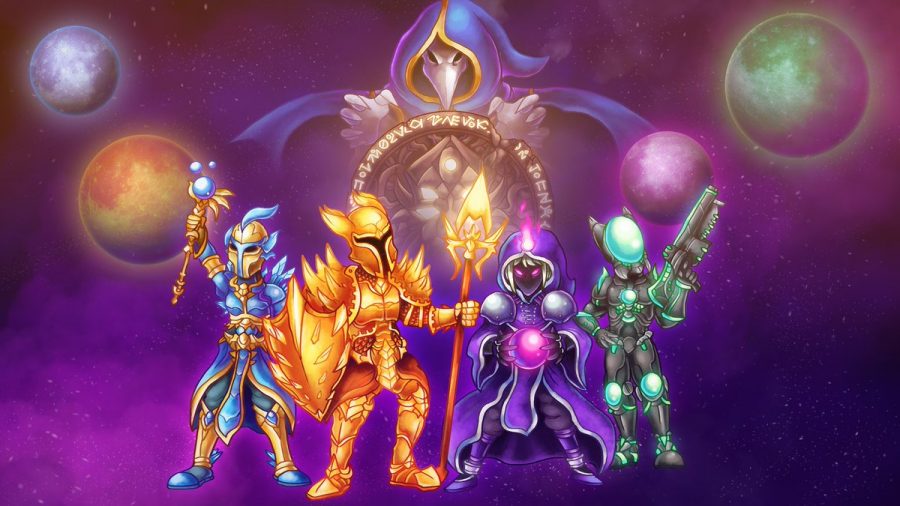“Terraria”: A review
An easily overlooked indie game, and what makes it stand out.
March 2, 2018
Ever wanted to fight giant flying eyeballs, cast magic spells, explore a dungeon, ride a unicorn, fend off a goblin army, have a gun that’s also a shark, fly on a carpet, talk to a mushroom person, summon your own minions, go to Hell, break curses and vanquish a great evil, all in a beautiful, brilliantly designed 2D world? Well, have I got the game for you. Yes, in fact, everything I just listed is possible in “Terraria”.
That long, extensive list is only a fraction of what “Terraria” has to offer. At first glance, the game may seem like a two dimensional “Minecraft” but a closer look reveals a unique and incredibly polished experience. Perhaps the greatest thing about “Terraria” is just how much there is to do. For ten dollars, it really is a bargain. The first step to starting the game is character creation. Hair, clothing, skin and eye color are extremely customizable, despite the small size of the player character. A “random” button is provided for those who would like to speed up the process, which changes everything except character difficulty. After the player is happy with their character, they may name it and continue.
The next step is world creation. Worlds can be small, medium, or large, and also have a difficulty setting. Normal mode is the intended experience, while Expert offers more of a high risk, high reward challenge. World evil is chosen at random, unless the player has previously reached the endgame. Crimson and Corruption are the two options, both with similar yet unique gameplay experiences. Again, the player provides a name. Then the game actually generates the world, with a stylized progress bar and a series of funny messages to entertain players during the process.
Finally, the game is ready to play. You start at a set spawn location in a forest near the center of the world, with a set of copper tools and a friendly guide to help you survive. Although gameplay does focus mainly around gathering resources– be it from enemies, the environment, events, or farming –and fighting bosses to progress, there is so much more to the game than that.
Explorers can go hunting for hidden chests containing the rarest of artifacts, delving deep into the heart of the underground jungle, or high into the sky in search of floating islands. For the architects, there are hundreds of different block types, walls, platforms, furniture sets, and other decorative items to collect and experiment with. Are you an engineer who likes automation and making traps? Stop by the mechanic and pick up some wires, actuators and a wrench to get started. Even the basic progression system has alternatives for different playstyles. If you aren’t a fan of exploring and searching the world for rare ores or chests, try fishing instead. The fishing minigame is simple, yet rewarding for the patient player.
Combat also offers a wide variety of classes, each with viable subclasses. The main four are melee, ranger, mage and summoner. Players aren’t locked into one class, however. “Terraria” is very flexible regarding weapon type, limiting players only by what is available. A character wearing mage’s armor can still swing a sword and shoot a bow, provided they have arrows.
Basically, there’s a lot of content. The game’s mechanics are strong enough to provide a worthy objective, and the pathways to any goal are all interesting and fun. Most fights aren’t urgent, so you can postpone a fight with the Eater of Worlds to work on your base instead. The freedom “Terraria” gives players is astounding. As with any game, though, there are some drawbacks.
For one, the vast amount of content can be overwhelming to new players. The in-game guide NPC can be useful, but he only explains crafting recipes and gives vague hints. Specific information about boss summoning, for example, is often unclear. A player may simply have to use guesswork or visit the official Terraria Wiki for help.
Often times, finding a certain accessory or item can be very tedious. Some have a rare chance to drop from an enemy, and others aren’t even obtainable in every world. This is understandable, because these items include some of the most powerful in the game. Nevertheless, I do think there’s room for improvement. Many players are forced to create new worlds, set up complicated enemy farms or spend hours scouring the land for the rare drops they want.
Those are really the only two problems I have. The price is great for the content included, and the gameplay is unique. “Terraria” is an unforgettable gem of an indie game.
